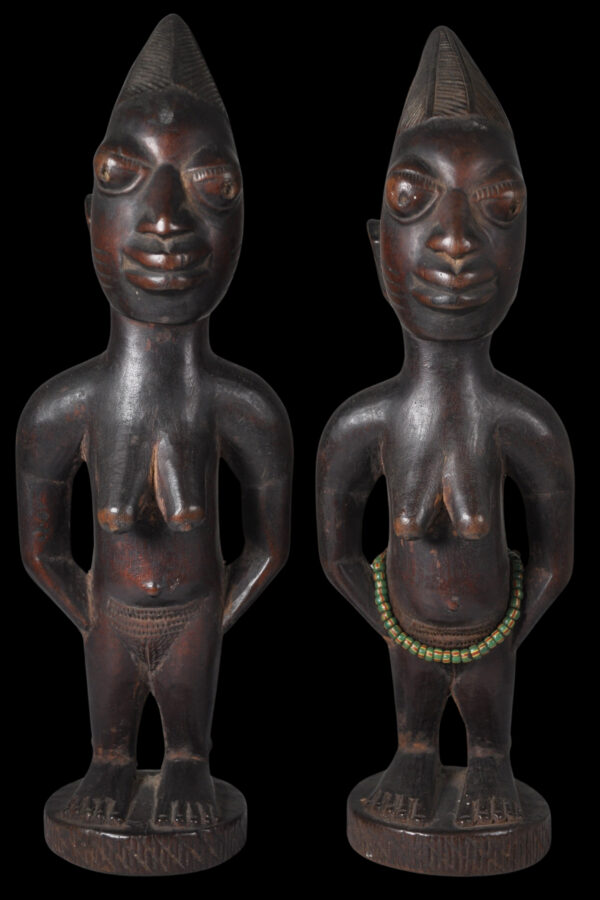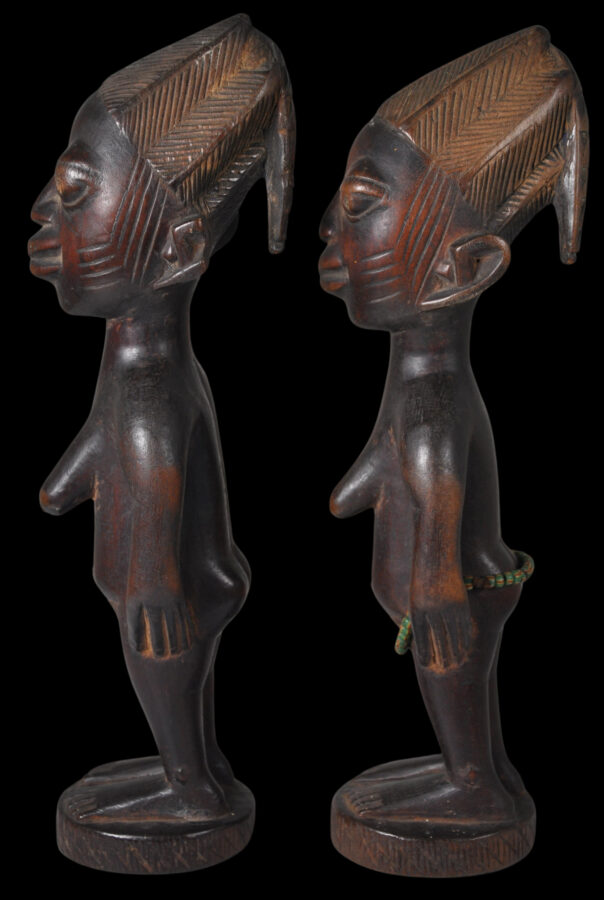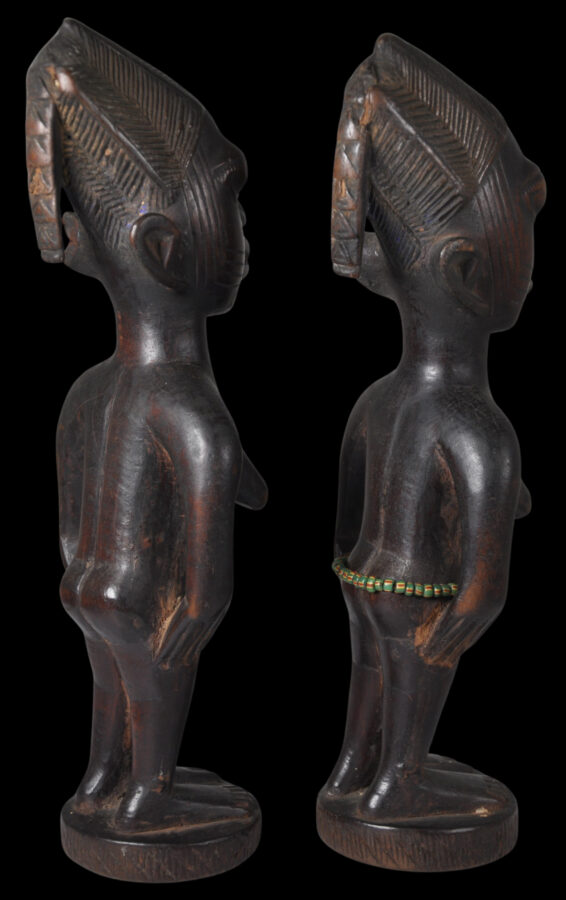This pair of female Ere Ibeji twins is unusual in that they also incorporate Eshu characteristics.
Each has a good, deep patina with contours that have been softened and rounded from handling. Also, they are a clear pair and are essentially identical.
Both stand with hands on hips, legs apart, and with protruding breasts. Their beautifully rendered faces are characteristically long, with wide but sleepy almond-shaped eyes; flared nostrils; full broad and protruding lips; and strong ears carved towards the backs of the heads. The eyes are particularly bulging and have heavy, thick eyelids decorated with incised eye lashes. Both have large heads: the over-sized head is deliberate – the head is where the spirit resides. Among the Yoruba, the over-sized head is associated with one’s destiny, and can be a measure of one’s likely success or failure.
The facial scarification markings are particularly interesting and extensive. Each cheek has four horizontal scarification lines, and then sides of each of their faces are incised with five lines running diagonally from the hair lines.
The tall coiffure of each resembles a high crown beautifully gadrooned in an angular manner. The backs of the hairstyles include carved wooden pendant drops of a type usually seen on figures made for Eshu worship, suggesting that this pair served a dual purpose of being both Ibeji figures and Eshu figures.
Such Ibjei figures devoted to Eshu are rarely encountered. A related pair is illustrated in Chemeche (2013, p. 275).
The toes of each here are beautifully carved with toe nails clearly delineated.
Each stands on a raised, round platform, the sides of which have been cross-hatched.
One wears a waist band of green, red and white striped glass trade beads.
Each has an unusually large incised triangular patch of pubic hair.
The toes and other crevices show remnants of tukula powder. This powder was ground from tukula wood and was both a cosmetic and a protection from insects and from the sun. Tukula also was believed to have healing properties and magical powers.
Eshu is one of the most well-known deities in the traditional Yoruba belief system. Generally, Eshu is believed to be male. But Witte (2002, p. 78) argues that Eshu is both male and female. As both male and female, Eshu mediates between both sexes and bridges the sexual energies between men and women.
According to Chemeche (2013, p. 26), Eshu is a trickster who is able to be good and bad, trustful and mischievous, and can deliver prosperity or cause misery. He is the protector of travellers. Most importantly, he is the mediator between the realm of spiritual and mortal worlds. Hence he is the guardian of all rituals. He supervises all the sacrifices to the gods. His long phallic coiffure is unique. It symbolises a power that is both creative and destructive. This power allows him to bless those who perform their rituals properly and correctly with good fortune, and to bring misery to those who do not perform their rituals properly. Eshu is therefore often represented on the shrine alongside other deities.
Yoruba people have the highest dizygotic (non-identical) twinning rate in the world. The birth of twins amongst Yoruba women are four times more likely than anywhere else. Unfortunately, the mortality rate of the twins also was high. Ere Ibeji figures were carved as spiritual representations of the twins who died. These figures were commissioned from village carvers, who were also often highly trained priests (Babalawo). The images were carved as adults, rather than as the deceased infants. It is common in African sculpture that representations of children are made with adult-like qualities, including elaborate coiffures, scarifications on the face, fully developed breasts (on female figures), pubic hair and prominent genitalia. They were usually placed on a shrine dedicated to Elegba (a divine messenger deity) in the living area of the house and fed, bathed and dressed regularly. These figures were particularly special to the mother, who kept them close to her and caressed the figures in a loving manner, hence the wear that genuinely old examples exhibit.
The pair here is in fine condition. There is some old loss to the top of one ear of one.
References
Bacquart, J. B., The Tribal Arts of Africa, Thames & Hudson, 1998.
Chemeche, G., Eshu: The Divine Trickster, Antique Collectors’ Club, 2013.
Fagg, W. and J. Pemberton, J., Yoruba: Sculpture of West Africa, Collins, 1982.
Polo, F., Encyclopedia of the Ibeji, Ibeji Art, 2008.
Rowland, A., H.J. Drewal, and J. Pemberton, Yoruba: Art and Aesthetics,Museum Rietberg, Zurich, 1991.
Witte, H., “The World View and Iconography of the Yoruba” in Forms of Wonderment: The History and collections of the Afrika Museum Berg en Dal, Afrika Museum Berg en Dal 2002.











